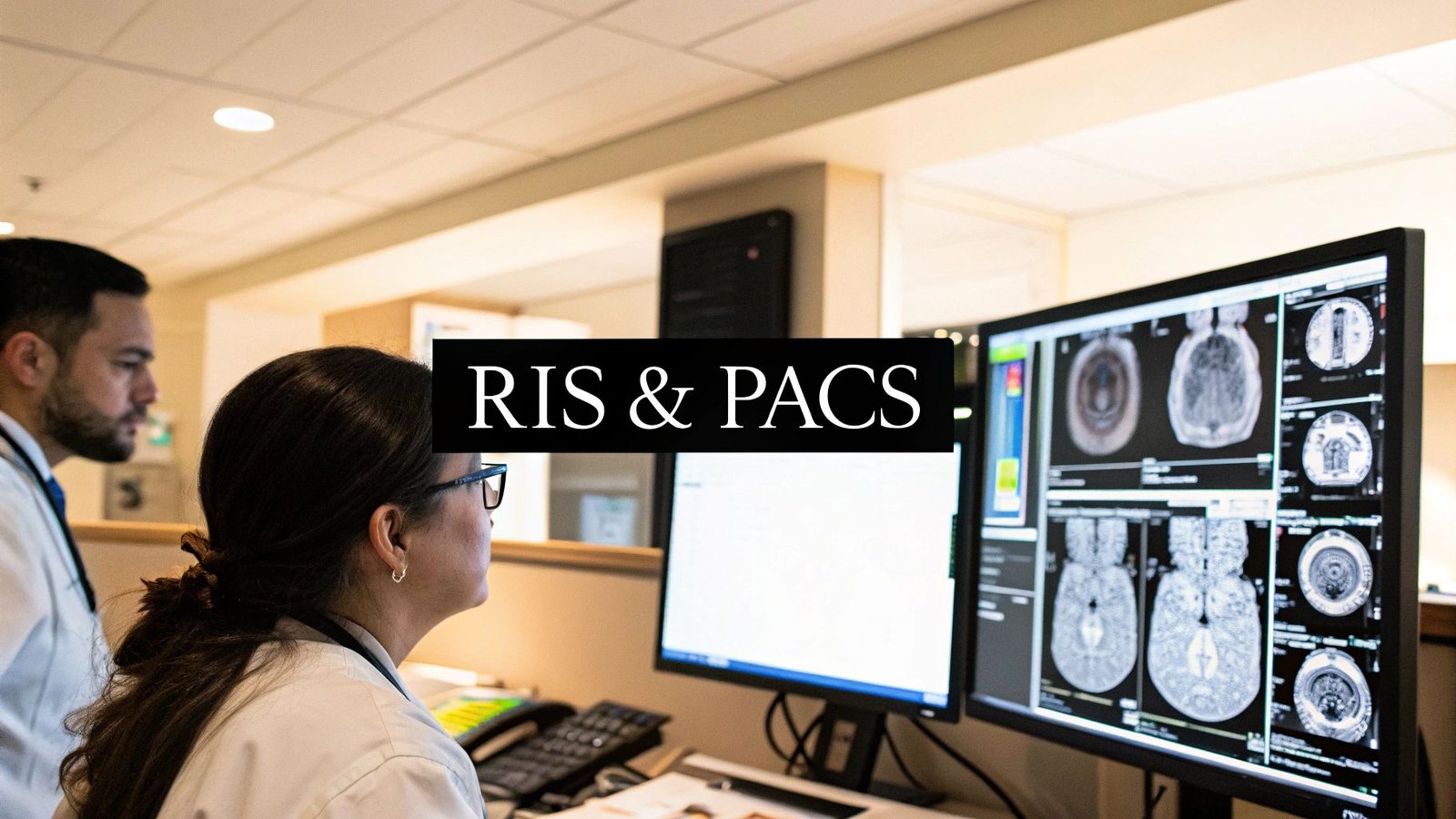In medical AI, the quality of your training data directly dictates the reliability of your diagnostic models. A poorly labeled dataset can lead to inaccurate algorithms, jeopardizing clinical outcomes and regulatory approval. This is why selecting one of the best image annotation tools is a critical, foundational step for any project involving medical imaging, from radiology to pathology. The right platform not only accelerates your labeling workflow but also enforces the pixel-perfect precision required to identify subtle anomalies in MRIs, CT scans, and ultrasound images.
This guide moves beyond generic feature lists to provide a comprehensive analysis of the top image annotation platforms tailored for complex medical use cases. We'll examine each tool’s capabilities for handling DICOM and NIfTI formats, its support for specialized annotation types like polygons and semantic segmentation, and its collaboration features for teams of clinicians and data scientists. Furthermore, managing sensitive patient data requires strict adherence to privacy regulations, making robust security protocols and an understanding of HIPAA compliant document sharing essential when choosing a platform.
Here, you will find in-depth profiles of tools like Labelbox, V7 (Darwin), Encord, and open-source alternatives like CVAT, complete with screenshots, direct links, and honest assessments of their strengths and limitations. Our goal is to equip medical device manufacturers, research institutions, and healthcare technology companies with the practical insights needed to choose the optimal solution for their specific annotation challenges, ensuring data integrity from the very start.
1. Free AI Medical Imaging Annotation – PYCAD – Your Medical Imaging Partner.
PYCAD's Free AI Medical Imaging Annotation tool establishes itself as a powerful, standout option among the best image annotation tools, particularly for medical professionals who prioritize speed, accessibility, and data security. This entirely browser-based platform eliminates the need for complex software installations or powerful local hardware, making advanced AI-driven segmentation accessible to anyone with an internet connection. Users can simply upload DICOM files and receive fully automated segmentation outputs in the widely used NIfTI format, dramatically accelerating diagnostic and research workflows.
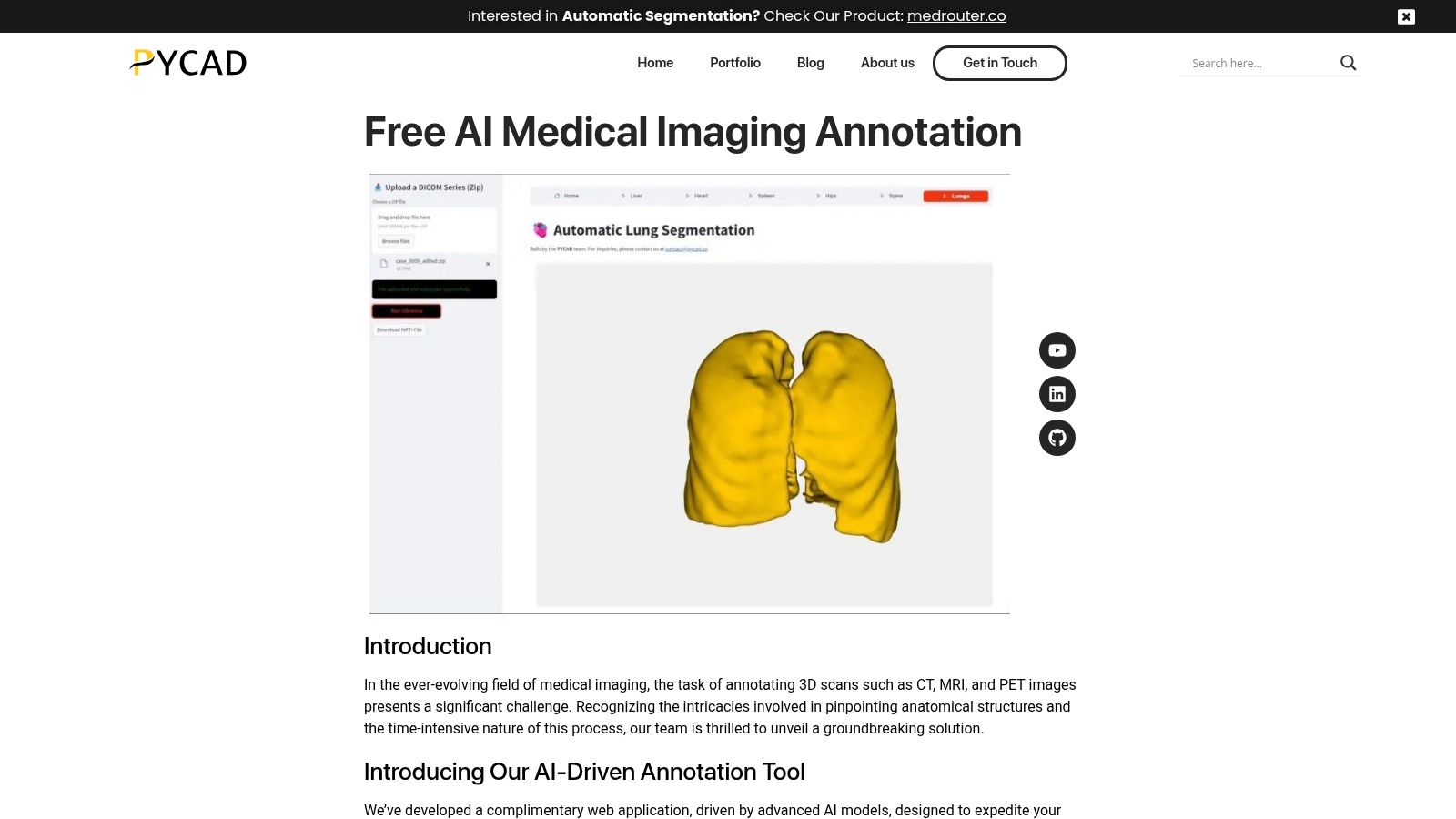
The platform’s core strength lies in its elegant simplicity and robust backend technology. Developed by experts in AI-driven medical imaging, the tool delivers reliable, state-of-the-art automated annotations without a learning curve. This makes it an ideal solution for quick preliminary analyses, academic research where resources are limited, or for clinicians needing a rapid second opinion on segmentation tasks.
Key Strengths and Practical Use Cases
What truly distinguishes PYCAD is its uncompromising stance on data privacy. In a field governed by strict patient confidentiality standards like HIPAA, the platform’s automatic hourly deletion of all uploaded data is a critical feature. This provides a secure environment for handling sensitive medical images, reassuring users that their data is not stored or repurposed.
- Rapid Prototyping for Research: Medical researchers can use the tool to quickly generate baseline segmentations for large datasets, saving hundreds of manual annotation hours.
- Educational and Training Tool: Academic institutions can leverage the free tool to teach students about medical image segmentation without investing in expensive software licenses.
- Clinical Workflow Enhancement: A radiologist can use it to get a quick, automated segmentation of an organ or anomaly before beginning a more detailed manual analysis, streamlining their process.
Platform Analysis
| Feature | Assessment |
|---|---|
| Accessibility & Cost | Completely free and browser-based. No downloads, installations, or credit card required, removing all barriers to entry. This is a significant advantage over competitors. |
| Core Functionality | Automated DICOM to NIfTI segmentation. The focus is singular but powerful: providing high-quality automated annotations with minimal user effort. |
| Data Privacy | Exceptional. Automatic hourly data deletion is a non-negotiable benefit for any user handling protected health information (PHI), making it a top choice for security. |
| Limitations | No long-term storage or advanced customization. The hourly data wipe means it's not a project management tool. Users seeking fine-grained manual adjustments may need another solution. |
PYCAD offers a streamlined, secure, and highly efficient solution that excels in its niche. While it may not replace comprehensive, feature-rich annotation suites, its value as a free, instant, and secure tool is undeniable for the medical imaging community.
Website: https://pycad.co/free-ai-medical-imaging-annotation/
2. Labelbox
Labelbox positions itself as a comprehensive data development platform, extending beyond simple annotation to include data curation, model experimentation, and robust project management. For medical imaging teams, its strength lies in providing a unified environment to manage the entire data pipeline, from selecting relevant DICOM series in its Catalog feature to deploying trained models. This integrated approach makes it one of the best image annotation tools for organizations looking to streamline complex, iterative development cycles.
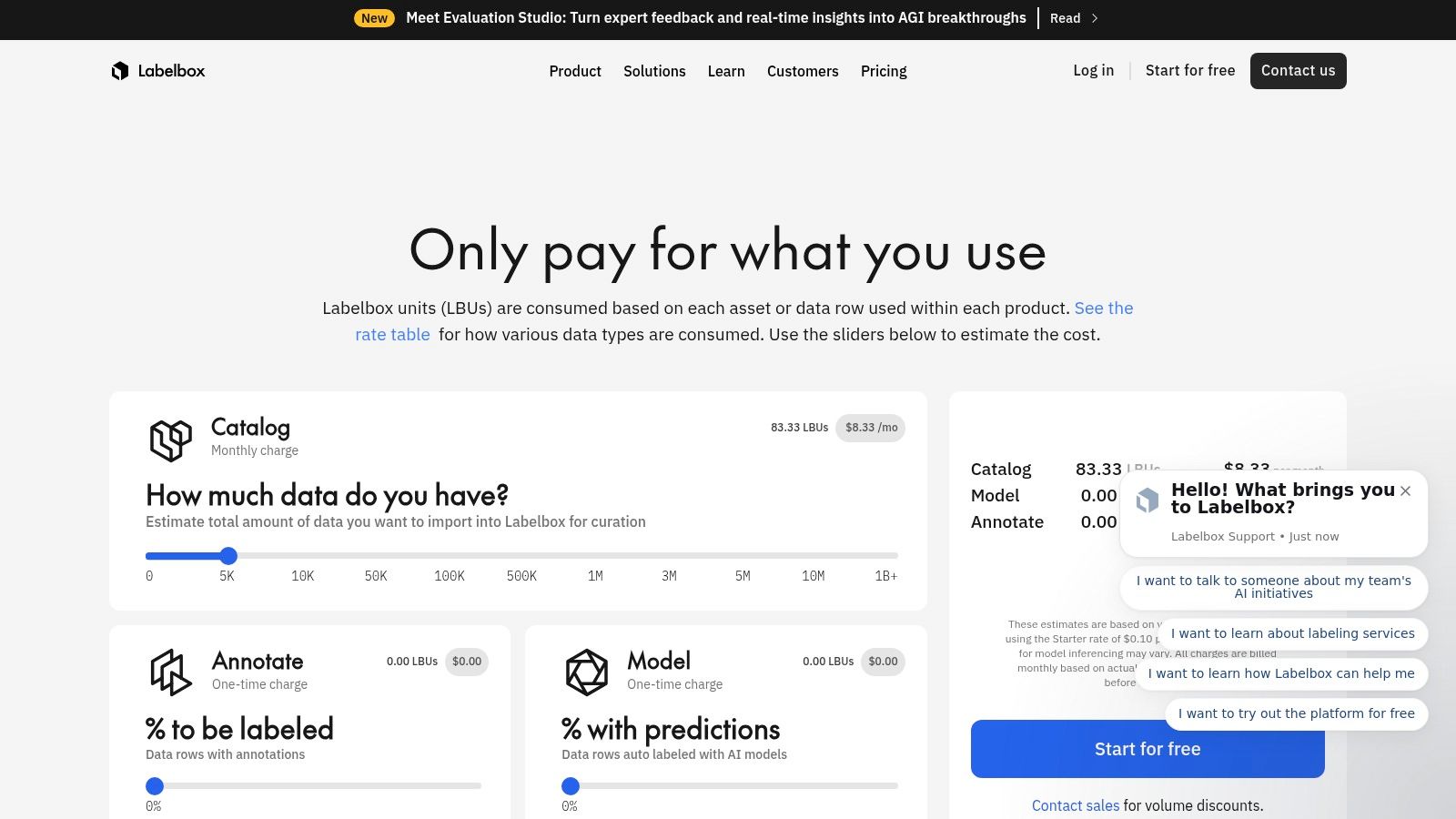
The platform is particularly well-suited for teams requiring granular control over data access and annotation quality. It offers sophisticated workflows with role-based permissions, consensus mechanisms, and detailed review stages, which are critical for maintaining data integrity in regulated medical environments.
Key Features and Implementation
Labelbox’s pay-as-you-go pricing model, based on "Labelbox Units" (LBUs), offers transparency and scalability. Users can leverage the online calculator to estimate costs based on data volume, annotation complexity, and team size. While this offers flexibility, it requires active monitoring to prevent costs from escalating on large-scale projects.
- Data Curation & Annotation: The platform's Catalog allows teams to search, visualize, and curate vast medical imaging datasets before labeling begins. The Annotate module supports complex polygons, segmentation masks, and DICOM-specific tools.
- Quality Management: Implement multi-step review workflows, calculate consensus scores between annotators, and assign specific roles (e.g., Labeler, Reviewer, Admin) to ensure high-quality ground truth data.
- Enterprise Scalability: With robust SDKs and APIs, Labelbox integrates into existing MLOps stacks. For teams needing extra capacity, optional managed labeling services are available to handle large annotation workloads.
For medical AI startups, the platform's ability to scale from a small pilot project to a full enterprise deployment is a significant advantage, accommodating growth without requiring a change in tooling.
3. SuperAnnotate
SuperAnnotate provides an end-to-end data infrastructure platform designed for building high-quality training data with speed and precision. Its key differentiator is a high degree of customizability, allowing teams to build bespoke annotation environments tailored to specific medical imaging needs, from pathology slide analysis to surgical video segmentation. This flexibility makes it one of the best image annotation tools for research and development teams tackling novel or complex annotation challenges that standard interfaces cannot accommodate.
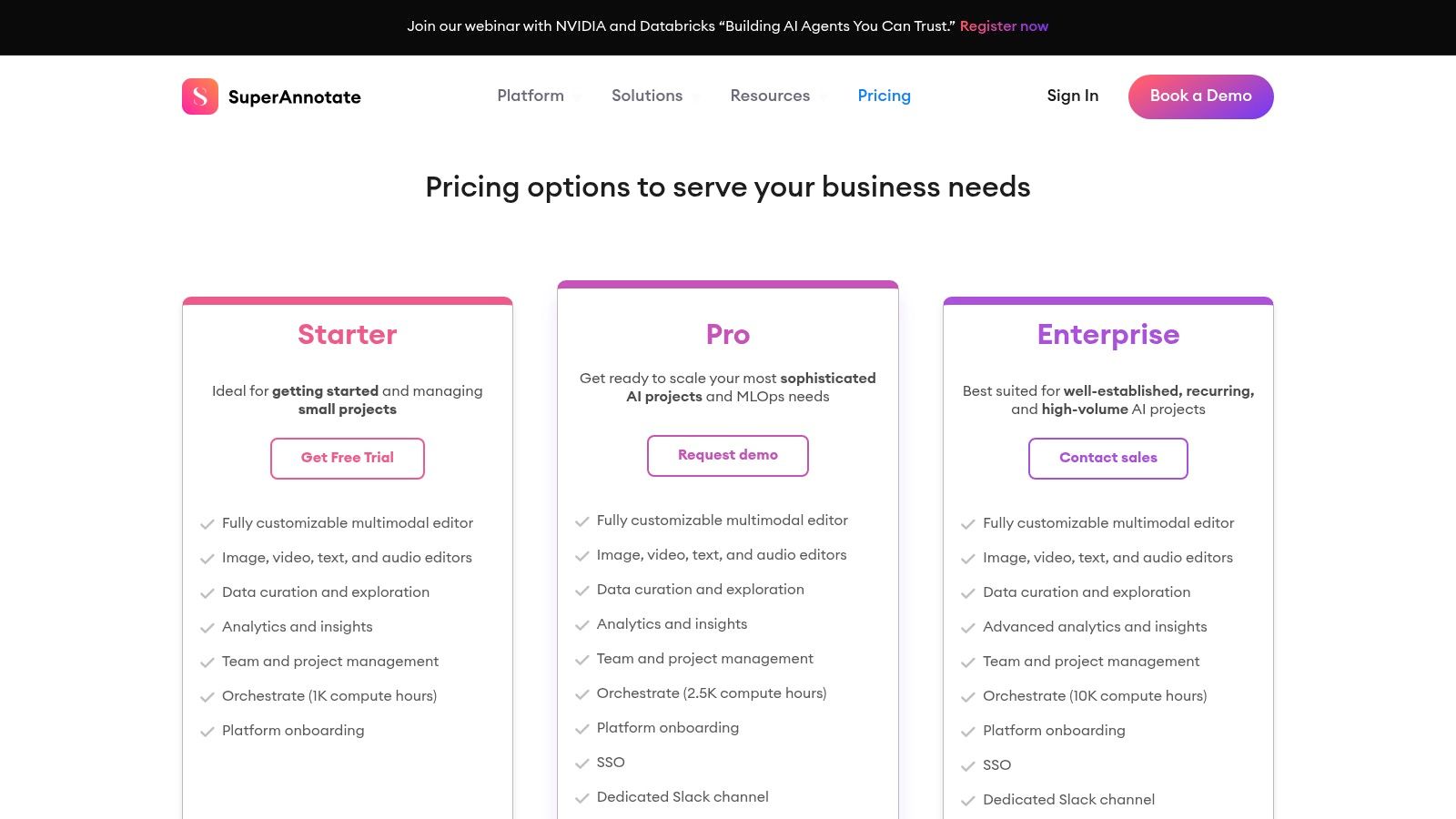
The platform excels in managing large-scale projects where both quality control and workflow efficiency are paramount. Its integrated project management, quality assurance automation, and data curation tools provide a unified workspace. This is particularly valuable for teams that need to not only annotate but also search, filter, and manage vast datasets using vector or natural language queries before labeling even begins.
Key Features and Implementation
SuperAnnotate offers a free Starter plan for small teams, while its Pro and Enterprise tiers are priced by quote, catering to organizations with advanced security and workflow needs. Implementation of its more advanced features, such as the Orchestrate tool for building custom logic flows, requires initial setup but yields significant long-term efficiency gains by automating tasks like data distribution and quality checks.
- Customizable Annotation Editors: Use the no-code Builder to design unique annotation interfaces. This is ideal for creating project-specific tooling for complex tasks like multi-layered organ segmentation or linking findings across different image modalities.
- Intelligent Data Curation: The Explore tool enables vector and similarity searches on unstructured image data, allowing teams to identify edge cases, reduce data redundancy, and curate balanced datasets efficiently.
- Automated Workflows: Leverage the Orchestrate feature to design and automate complex data pipelines, from assigning tasks to annotators based on skill level to triggering automated consensus scoring for quality assurance.
For medical AI companies requiring specialized annotation environments and powerful automation, SuperAnnotate offers a highly adaptable and scalable solution that can be molded to fit unique project requirements.
4. V7 (Darwin)
V7 (Darwin) is an enterprise-grade training data platform with a strong specialization in medical imaging, particularly for complex modalities like DICOM and video. Its key differentiator is the powerful AI-assisted labeling engine, which uses autoML to learn from annotator corrections and progressively automate segmentation tasks. This makes it one of the best image annotation tools for teams looking to accelerate the creation of highly accurate ground truth data for demanding medical AI applications.
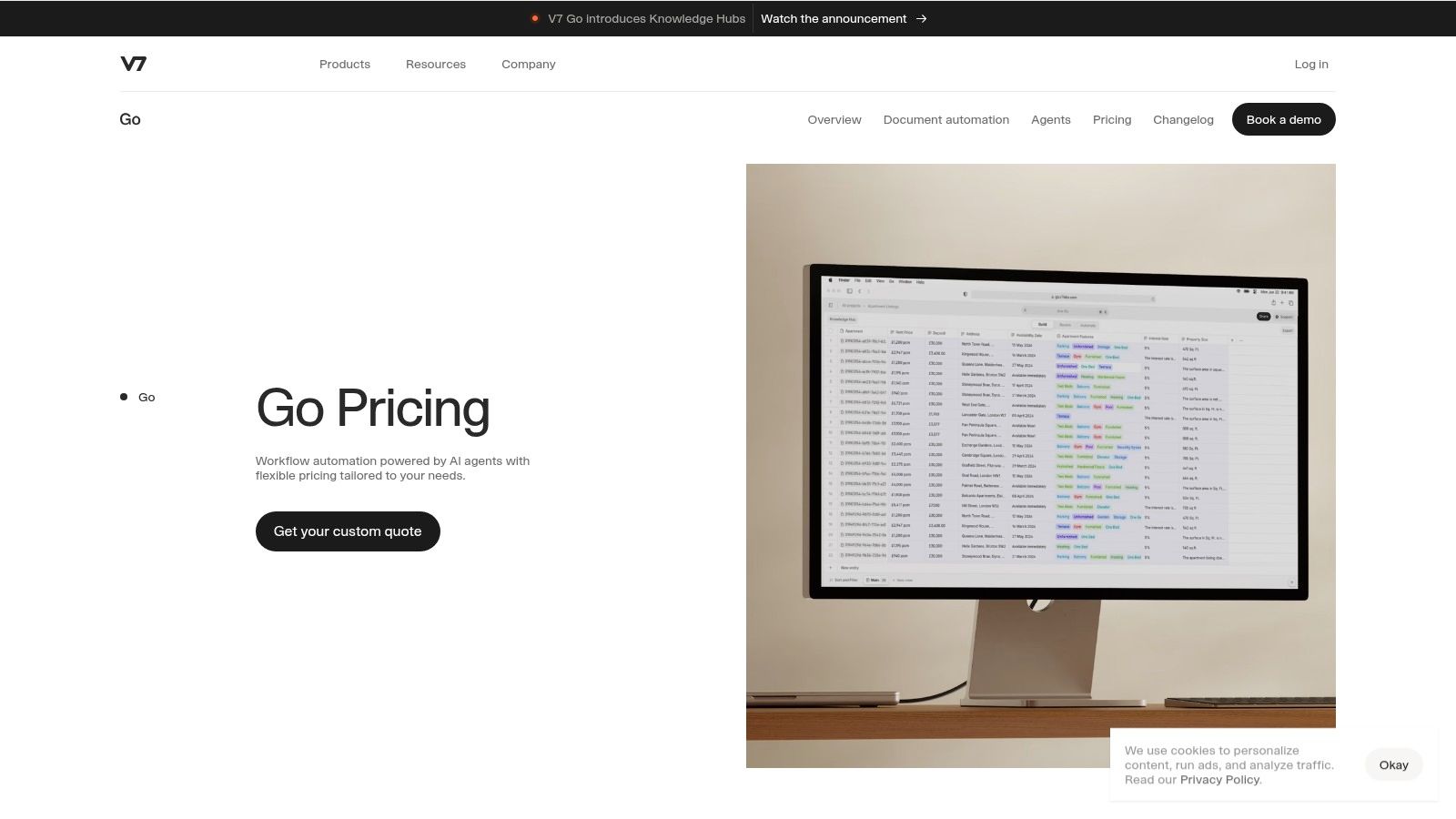
The platform is designed for organizations where compliance and security are paramount. With features like SSO/SAML, role-based access control, and options for Virtual Private Cloud (VPC) deployment, it meets the stringent requirements of healthcare and other regulated industries. This focus on enterprise governance provides the necessary security and auditability for handling sensitive patient data.
Key Features and Implementation
V7 offers several pricing tiers, including a "Go" plan with clear per-image automation pricing, while its more comprehensive Darwin enterprise plans are customized by quote. The platform's real-world data and model management capabilities are designed to handle the entire MLOps lifecycle, from initial annotation to model-in-the-loop validation and retraining.
- AI-Assisted Annotation: Leverages autoML for model-assisted labeling, significantly reducing manual effort for complex segmentation. The tool supports DICOM-native rendering and video annotation with object tracking.
- Workflow & Quality Control: Create multi-stage workflows with customizable logic and quality gates. Annotator performance analytics and consensus scoring ensure data consistency and accuracy across large teams.
- Enterprise Governance: V7 provides robust security features, including advanced user permissions and options for on-premise or VPC deployment, making it suitable for organizations with strict data privacy and compliance needs.
For medical AI teams, V7’s human-in-the-loop workflow, where models assist human annotators, creates a powerful feedback cycle that not only speeds up labeling but also improves model performance over time.
5. Encord
Encord is an advanced data development platform engineered for visual and multimodal AI, making it a powerful choice for medical imaging. It distinguishes itself by integrating sophisticated active learning, model evaluation, and in-depth analytics directly into the annotation workflow. This approach allows teams to move beyond basic labeling and build a continuous improvement loop where model performance directly informs data selection and quality control, making it one of the best image annotation tools for data-centric AI development.
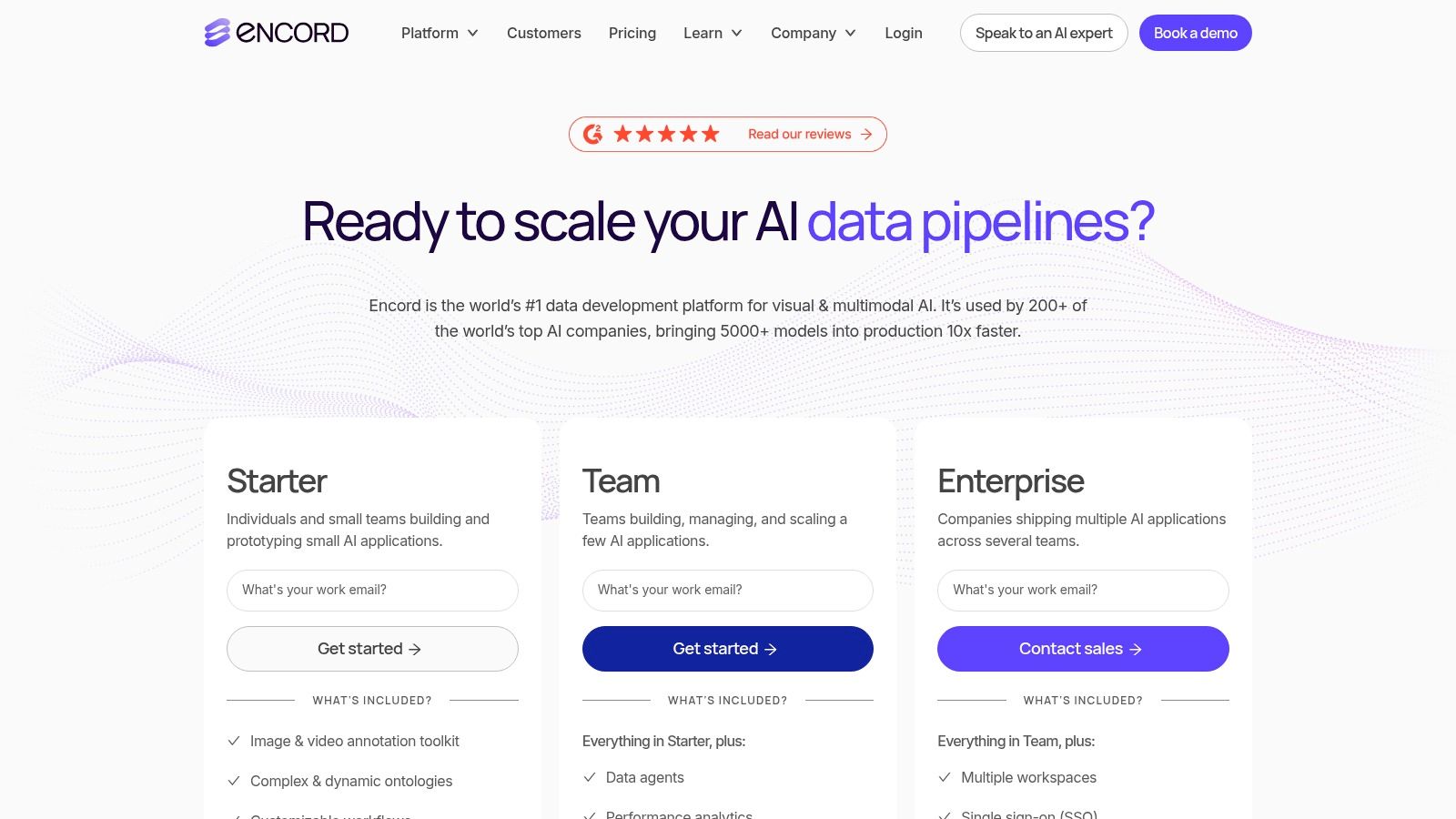
The platform is particularly suited for organizations with stringent security and compliance requirements, such as those handling sensitive patient data. With HIPAA, GDPR, and SOC 2 compliance, alongside flexible deployment options including on-premise and VPC, Encord provides the security framework necessary for enterprise-level medical AI projects.
Key Features and Implementation
Encord’s pricing is customized for enterprise needs, and teams must contact sales for a quote, which reflects its focus on tailored, large-scale deployments. While this model is less transparent for smaller teams, it ensures that the solution is configured for specific project requirements. The platform's extensive feature set may be more than what's needed for simple annotation tasks.
- Active Learning & Data Curation: Encord’s Data Agents automate data handling, helping teams prioritize the most valuable data for annotation based on model performance. This significantly reduces labeling costs and improves model accuracy.
- Integrated Model Evaluation: Unlike many tools, Encord incorporates model evaluation directly, allowing teams to analyze model failures, identify data drift, and find edge cases within the same environment where data is labeled.
- Compliance & Deployment: The platform offers robust deployment flexibility with cloud, VPC, and on-premise options. Strong compliance with HIPAA and SOC 2 provides the necessary security for handling protected health information (PHI).
For research institutions and medtech companies, Encord’s focus on analytics and quality assurance provides a robust framework for building high-performing, reliable medical imaging models.
6. Dataloop
Dataloop positions itself as a comprehensive data operating system, designed to manage the entire data lifecycle for AI, from annotation to model deployment. For medical imaging, its core strength lies in its powerful automation capabilities and support for diverse data types, including images, video, and 3D modalities like LiDAR. This unified approach makes it one of the best image annotation tools for organizations building complex, multi-modal AI systems that require seamless pipeline integration.
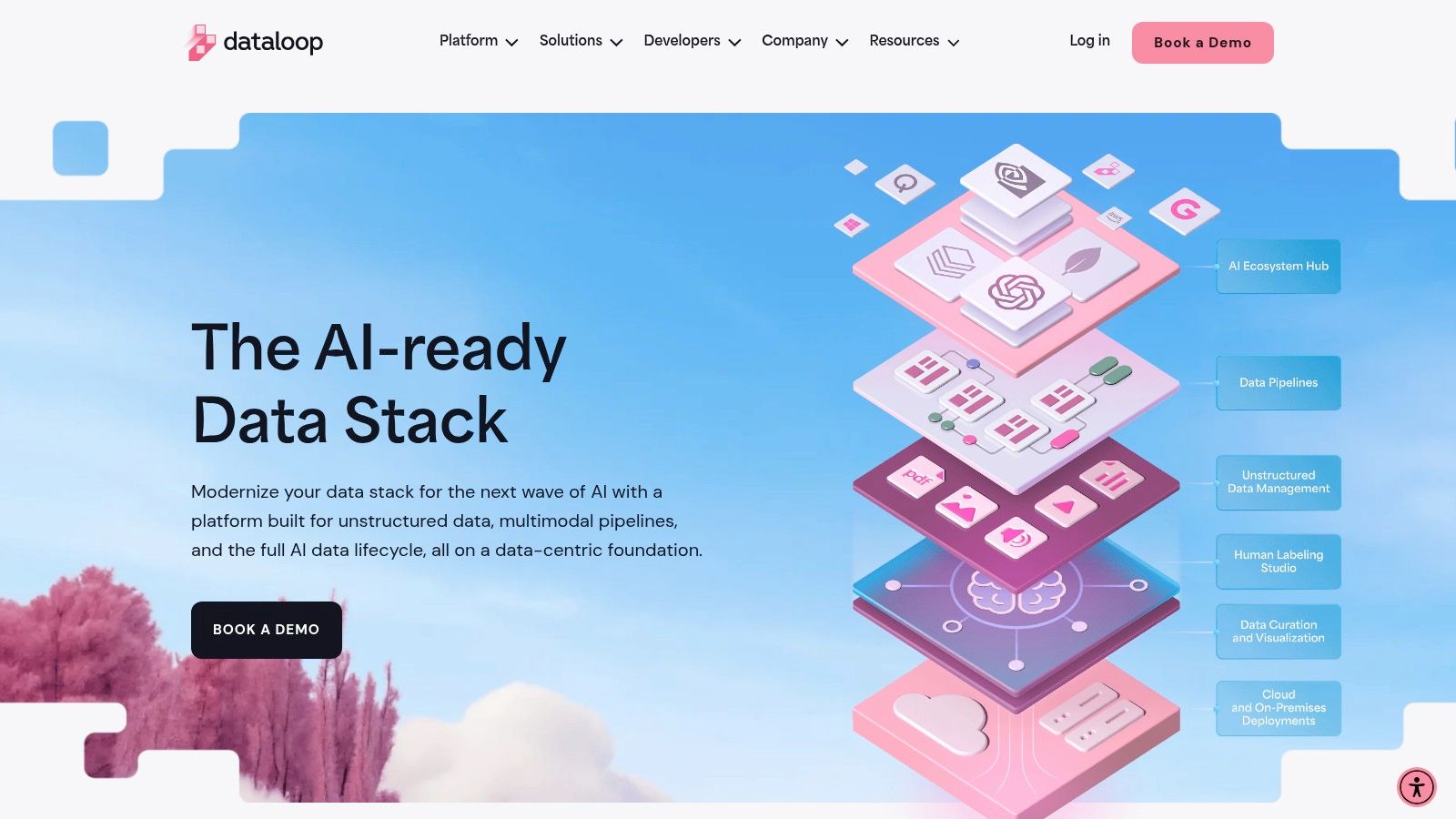
The platform is especially valuable for teams aiming to accelerate their labeling process through AI-assisted tools and automated workflows. Dataloop's focus on MLOps integration allows teams to create data loops where model predictions are used for pre-labeling, significantly reducing manual effort. While powerful, the platform's extensive capabilities can present a learning curve for teams new to data-centric AI operations.
Key Features and Implementation
Dataloop's pricing is primarily enterprise-focused and quoted via sales, with options available through the AWS Marketplace. This model is suited for large-scale deployments but may pose a high entry cost for smaller teams or pilot projects. The platform’s value is most evident when its full suite of automation and data management tools are leveraged.
- Automation & Pre-labeling: Utilize AI assistants, including an integration with the Segment Anything Model (SAM), for rapid instance segmentation. The platform supports model-assisted labeling where a custom model can pre-annotate new data.
- Multi-Modality Support: Dataloop offers specialized studios for various data types, including a GIS studio for geospatial data and tools for LiDAR point cloud annotation, making it suitable for projects combining different imaging sources.
- Workflow & Quality Control: Implement robust quality assurance pipelines with features like consensus scoring, qualification tests for annotators, and multi-step review processes to ensure data accuracy and consistency.
For advanced medical AI teams, Dataloop’s powerful SDK and API enable deep integration into existing infrastructure, creating an automated and scalable data engine for model development.
7. Roboflow
Roboflow offers an end-to-end computer vision platform that streamlines the entire workflow from data collection and annotation to model training and deployment. It stands out by providing a unified, developer-centric environment that simplifies the MLOps cycle, making it one of the best image annotation tools for teams wanting to move quickly from prototype to production. Its intuitive interface and extensive documentation lower the barrier to entry for building sophisticated vision models.
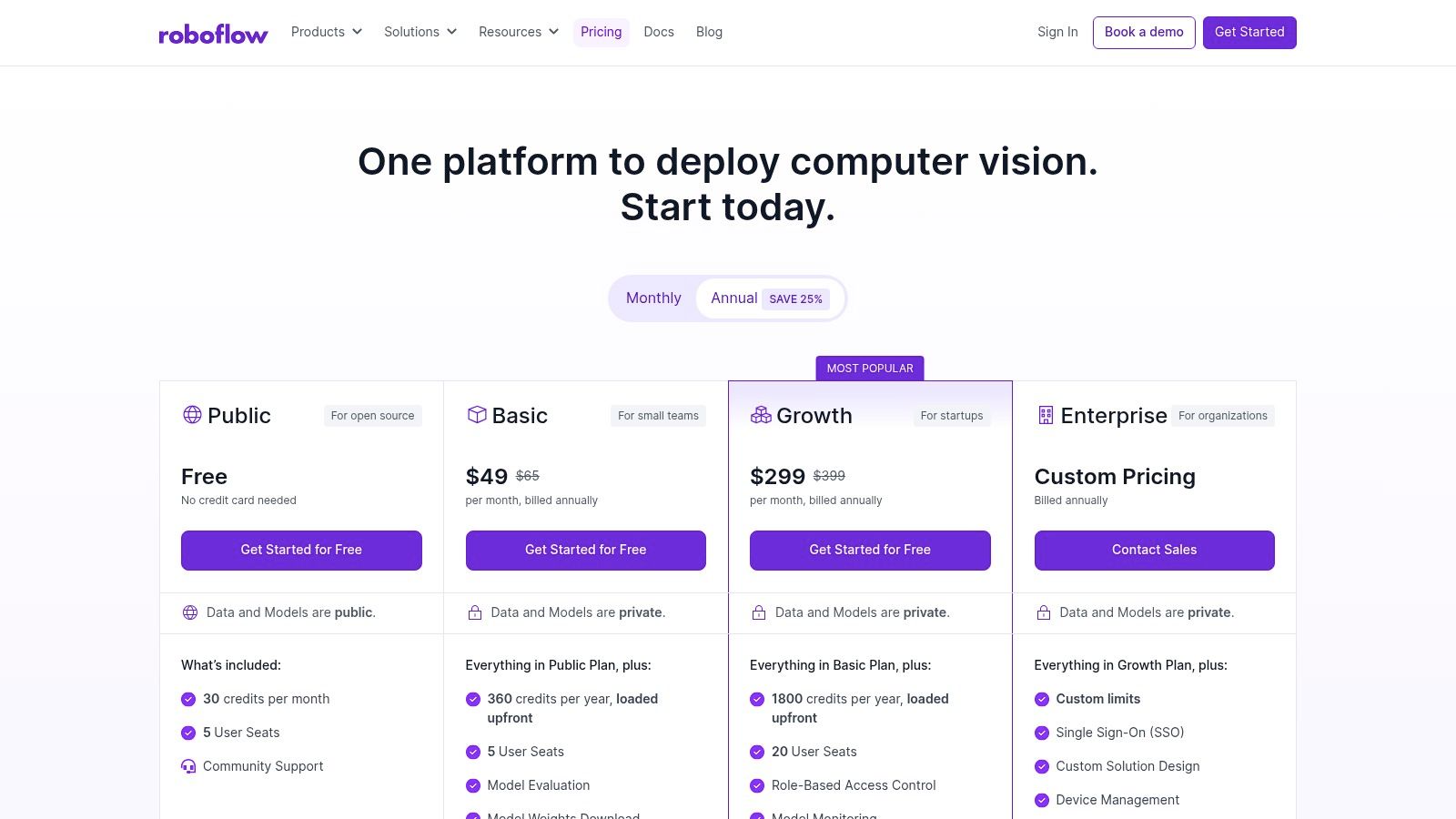
The platform is especially beneficial for rapid experimentation, allowing teams to version datasets, apply augmentations with a single click, and train models directly within the ecosystem. This integrated approach removes friction between the annotation and model development stages, accelerating iteration and improving efficiency for medical AI projects.
Key Features and Implementation
Roboflow’s pricing is structured around a credit-based system, with a generous free public tier and scalable paid plans (Basic, Growth, Enterprise) for private projects. Users can visit the pricing page to compare tiers based on dataset size, team seats, and model training needs. While the credit system is flexible, teams should monitor usage to align with project budgets.
- Integrated Workflow: Manage datasets, annotate with Roboflow Annotate, version data, train models using Roboflow Train, and deploy via a hosted API all in one place.
- Data Augmentation & Preprocessing: Automatically generate augmented versions of a dataset to improve model robustness, with options for resizing, grayscaling, and more.
- Collaboration and Versioning: Provides role-based access for team members and robust dataset versioning, ensuring traceability and reproducibility for experiments.
For research labs and startups, Roboflow’s comprehensive feature set and strong community support make it an excellent choice for building and deploying computer vision solutions without needing a large, dedicated MLOps team.
8. Supervisely
Supervisely positions itself as a versatile computer vision platform, moving beyond static images to offer specialized modules for video, 3D medical imaging, and point clouds. Its strength for medical teams lies in its ability to handle diverse data types within a single environment, from DICOM series to complex 3D scans. The platform's collaborative features are built for enterprise workflows, making it one of the best image annotation tools for large, distributed teams working with multi-modal data.

The platform is particularly well-suited for organizations requiring advanced labeling capabilities for dynamic or volumetric data. With features like object tracking in videos and native 3D data handling, it addresses use cases that many other tools cannot. Its focus on team-based quality assurance ensures data integrity across complex projects.
Key Features and Implementation
Supervisely’s pricing is modular, with separate add-ons for specialized features like advanced video or 3D labeling. This a la carte approach allows teams to pay only for what they need, but costs can accumulate for projects requiring multiple modules. The primary pricing is in euros, which introduces potential conversion variability for USD-based companies. The platform's pricing page details the various modules and editions available.
- Multi-Modal Data Support: Handles a wide range of data, including a custom video labeling player with object tracking, 3D point cloud annotation, and DICOM support with HIPAA-compliant anonymization tools.
- Collaboration & QA: Implements consensus and quality assurance workflows to manage team performance. Features like annotation agreement scoring and role-based access control are central to the platform.
- Enterprise Integration: Provides a robust Python SDK and REST API to integrate into existing MLOps pipelines, allowing for automation and custom workflow development.
For research institutions and medtech companies working with diverse imaging modalities, Supervisely’s flexibility and specialized toolsets provide a powerful, unified solution for complex annotation challenges.
9. Scale AI (Data Engine and GenAI Platform)
Scale AI presents a hybrid model that combines a powerful self-serve Data Engine with a fully managed enterprise solution, making it a flexible choice for medical imaging projects at any stage. Its platform is designed to handle the entire AI lifecycle, from data annotation and curation to model evaluation and generation. This dual-offering approach establishes Scale AI as one of the best image annotation tools for teams needing both the agility of a self-serve tool for pilots and the robust support of a managed service for large-scale deployment.
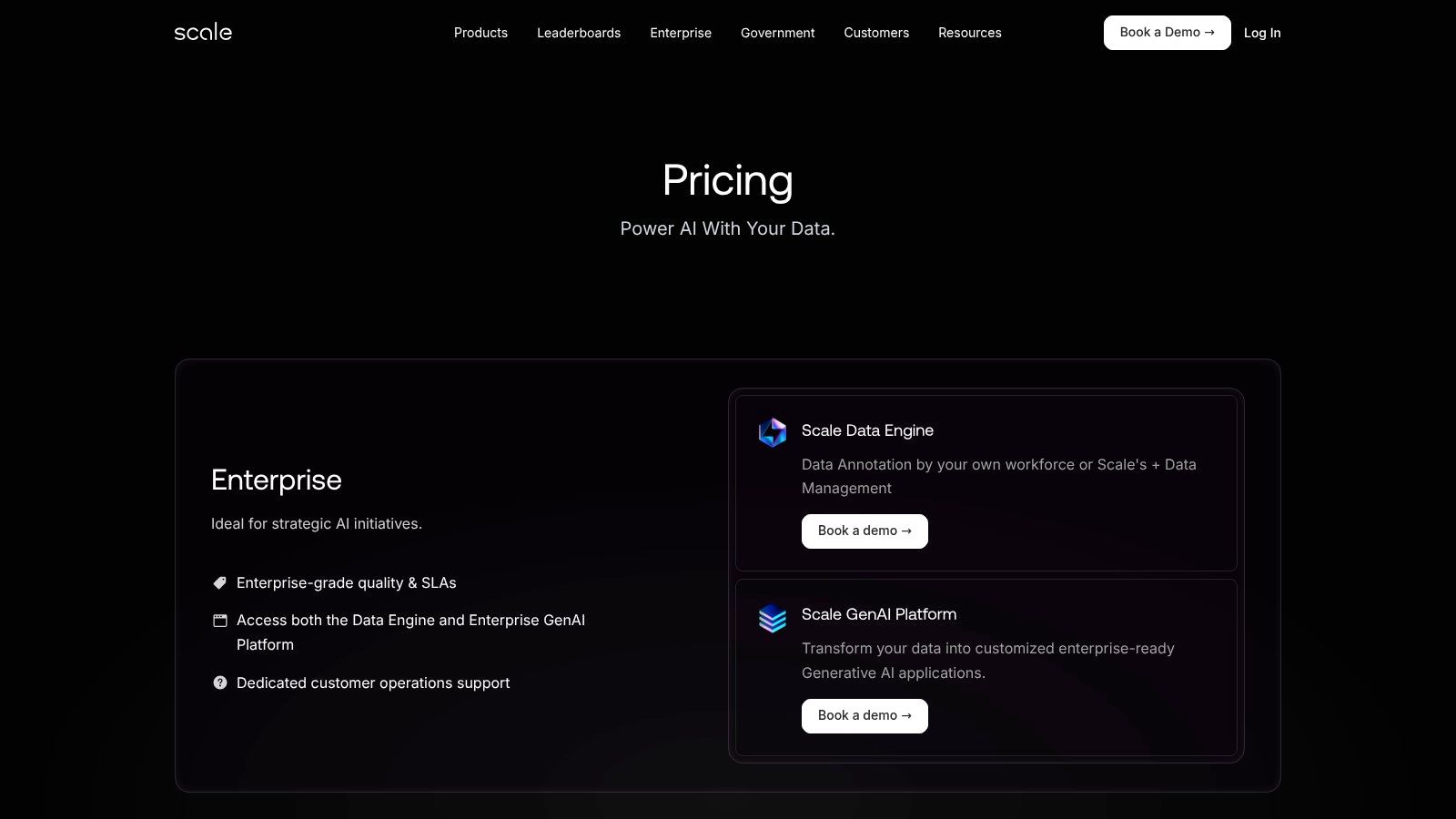
The platform’s major differentiator is its ability to cater to diverse workforce needs. Users can bring their own private workforce, use third-party vendors, or tap into Scale's managed team. For medical AI startups, the free starter quotas on the self-serve platform provide an excellent, no-cost entry point for prototyping and validating initial models before committing to a larger investment.
Key Features and Implementation
Scale’s self-serve Data Engine operates on a pay-as-you-go model with transparent pricing and free initial labeling credits, which is ideal for smaller teams and initial R&D. The full Enterprise and GenAI Platform is tailored via custom quotes, providing dedicated operational support and SLAs for mission-critical medical applications. While this enterprise model offers comprehensive features, it requires engaging with their sales team for pricing details.
- Flexible Workforce Integration: Seamlessly integrate your in-house annotation team, a third-party labeling service, or utilize Scale’s managed workforce within a single platform.
- End-to-End Data Management: The platform supports the full data pipeline, including data selection, annotation, quality assurance, and model evaluation workflows.
- Scalable Offerings: Start with the free tier on the self-serve Data Engine for small projects and seamlessly transition to the enterprise platform for production-level workloads without changing vendors.
While its recent leadership changes might be a consideration for long-term vendor stability, its powerful combination of self-service accessibility and enterprise-grade power remains a compelling option for medical imaging teams.
10. CVAT (Computer Vision Annotation Tool)
CVAT bridges the gap between open-source flexibility and managed service convenience, offering a powerful platform for teams that value both control and scalability. It began as a popular open-source project and has evolved to include hosted cloud and enterprise self-hosted editions. This hybrid approach makes it one of the best image annotation tools for organizations wanting the robust customization of open source without the full burden of self-management.
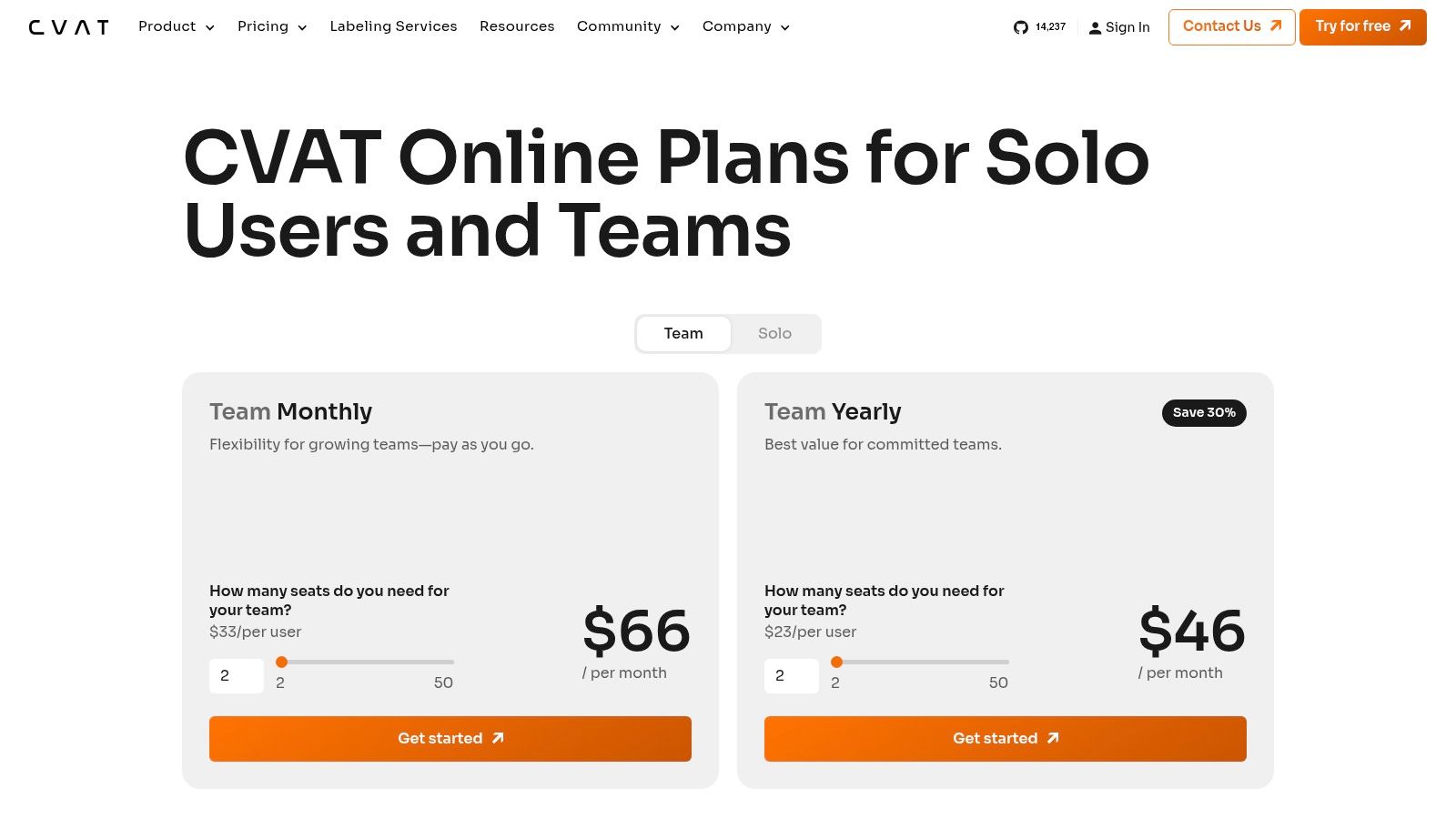
The platform is particularly appealing to teams looking for strong automation capabilities and seamless integration with the broader AI ecosystem. With direct integrations to tools like Hugging Face and Roboflow, CVAT streamlines the process of using pre-trained models to accelerate labeling tasks, a significant advantage for medical imaging projects dealing with large datasets.
Key Features and Implementation
CVAT.ai offers a clear, per-user pricing model for its cloud versions, starting with a free "Solo" plan that allows individuals to explore the tool's core functionality. Paid plans unlock team collaboration, API access, and advanced analytics. While the free plan is a great entry point, its limitations on projects and exports mean growing teams will quickly need to upgrade to a paid tier. The self-hosted Enterprise version is available for organizations requiring maximum security and features like SSO/LDAP support, though this demands dedicated IT resources.
- Flexible Deployment: Choose between the fully managed CVAT.ai cloud, a self-hosted enterprise deployment, or the foundational open-source version for complete control.
- Automation & AI Integration: Leverage built-in integrations with popular AI model hubs to implement semi-automated labeling, significantly reducing manual annotation time for complex structures in medical scans.
- Collaboration & Quality: The platform includes essential quality assurance tools for reviewing annotations, tracking team performance with analytics, and managing projects collaboratively.
- Strong Community & Support: The tool benefits from an active open-source community, providing a wealth of shared knowledge, while paid plans offer dedicated enterprise support.
11. Label Studio by HumanSignal
Label Studio stands out as a highly flexible, open-source data annotation tool, offering teams complete control over their labeling environment through its self-hosted Community Edition. For medical imaging projects where data security is paramount, the ability to deploy on-premise is a significant advantage. This extensibility, combined with managed cloud offerings from its parent company, HumanSignal, makes it one of the best image annotation tools for organizations wanting the freedom of open source with a clear path to enterprise-grade support.
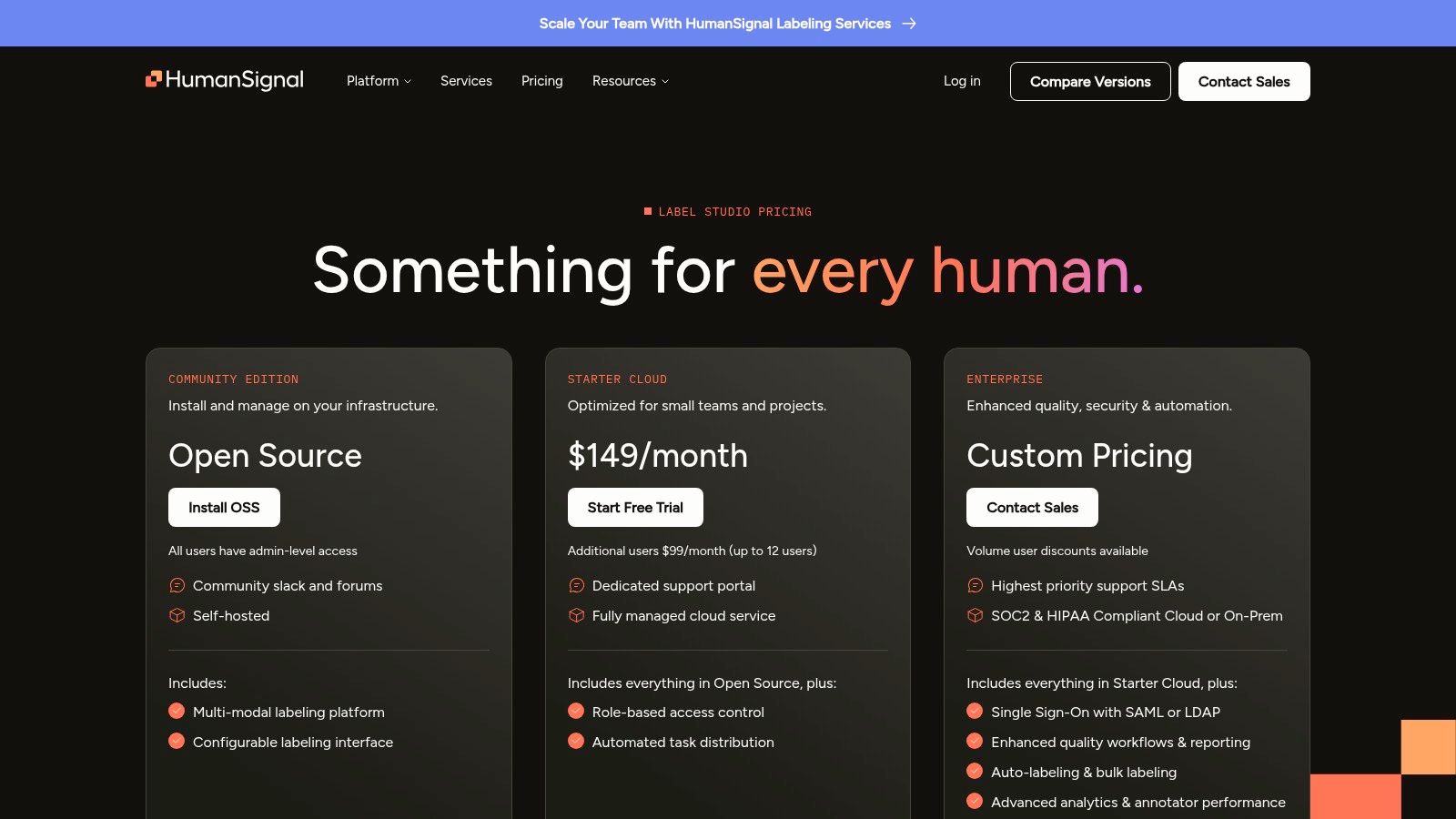
The platform is designed for customization, allowing developers to configure the labeling interface to match specific medical use cases, from DICOM viewing to complex segmentation tasks. This adaptability appeals to research institutions and startups that need a tool that can evolve with their project requirements without being locked into a rigid, proprietary ecosystem.
Key Features and Implementation
HumanSignal provides transparent pricing for its managed cloud versions, starting with an affordable Cloud Starter plan that adds essential team collaboration features. While this entry-level plan has a user cap, it offers a low-friction upgrade from the open-source version. The full Enterprise tier is built for regulated environments, adding features like SSO and advanced quality assurance workflows.
- Flexible Deployment: Choose between the free, self-hosted open-source version for maximum control or managed Cloud and Enterprise tiers for scalability and support.
- Configurable Labeling Interface: Use a simple XML-based configuration to create custom UIs for diverse medical annotation needs, including polygons, keypoints, and brush masks for segmentation.
- Team & Quality Management: The Cloud and Enterprise tiers add role-based access control (RBAC), automated task distribution, consensus analysis, and detailed annotator performance analytics to ensure data quality.
For teams starting with the open-source version, the well-documented API and strong community support provide a robust foundation for building a custom, powerful annotation pipeline.
12. Amazon SageMaker Ground Truth
Amazon SageMaker Ground Truth is a fully managed data labeling service that leverages the power of the AWS ecosystem. It is designed for teams already embedded in AWS infrastructure, offering a direct path from data storage in S3 to model training in SageMaker. Its key differentiator is the "active learning" feature, which uses a machine learning model to automatically label a portion of the data, significantly reducing the manual annotation workload and making it a cost-effective option for large-scale projects.
This integration makes it one of the best image annotation tools for organizations prioritizing security, compliance, and streamlined billing within a single cloud provider. The ability to choose between a private workforce, third-party vendors, or Amazon Mechanical Turk provides flexibility to match project requirements with the right skill set and budget.
Key Features and Implementation
SageMaker Ground Truth’s pricing is object-based, meaning you pay per image or frame labeled, with costs varying by annotation type. The active learning feature can reduce costs by up to 70% by minimizing human intervention. Prospective users can estimate expenses using the detailed examples on the AWS pricing page. While powerful, the user interface is less customizable than dedicated platforms, and costs can add up without careful management.
- Workforce Flexibility: Choose from your own internal team (private), AWS-vetted third-party vendors for specialized tasks, or Amazon Mechanical Turk for large, general-purpose annotation jobs.
- Active Learning: This feature automatically sends only the most challenging images to human annotators, letting an ML model handle the rest. This is ideal for medical imaging datasets with high-volume, repetitive patterns.
- Deep AWS Integration: Seamlessly connects with AWS services like S3 for data storage, IAM for access control, and SageMaker for model training, creating a unified MLOps environment.
For healthcare technology companies heavily invested in AWS, Ground Truth provides a native, secure, and scalable solution that simplifies the data labeling pipeline from start to finish.
Top 12 Image Annotation Tools Feature Comparison
| Product / Platform | Core Features / Capabilities | User Experience & Quality ★ | Value & Pricing 💰 | Target Audience 👥 | Unique Selling Points ✨ |
|---|---|---|---|---|---|
| 🏆 PYCAD Free AI Medical Imaging Annotation | Automated DICOM segmentation, NIfTI output | ★★★★☆ Browser-based, no install | 💰 Free, strong privacy focus | Medical pros & researchers | ✨ Hourly data deletion, max security |
| Labelbox | Data curation, annotation, model experimentation | ★★★★☆ Transparent unit pricing | 💰 Pay-as-you-go, managed options | Enterprises, data teams | ✨ Customizable workflows, managed labeling |
| SuperAnnotate | Multimodal annotation, custom UI builder | ★★★★☆ Robust project & quality controls | 💰 Pricing undisclosed publicly | Teams with complex labeling | ✨ No-code UI builder, workflow automation |
| V7 (Darwin) | AI-assisted segmentation, DICOM & video support | ★★★★☆ Specialized healthcare workflows | 💰 Quote-based, clear starter | Healthcare enterprises | ✨ Compliance features, autoML capabilities |
| Encord | Visual/multimodal annotation, active learning | ★★★★☆ Strong analytics & quality assurance | 💰 Pricing limited public info | Enterprises with compliance | ✨ Model evaluation, VPC & on-prem options |
| Dataloop | Image/video/LiDAR annotation, automation | ★★★★☆ Pipeline integration & geospatial data | 💰 Enterprise via sales | Large enterprises | ✨ Wide modality support, SAM integration |
| Roboflow | Dataset mgmt, annotation, training & deployment | ★★★★☆ Fast onboarding, integrated platform | 💰 Credit-based, tiered plans | Small teams & developers | ✨ Free public plan, team role controls |
| Supervisely | Video, 3D medical imaging, point clouds | ★★★★☆ Strong collaboration & QA | 💰 Modular pricing, EUR-based | Enterprises needing 3D/medical | ✨ HIPAA compliant anon, point cloud support |
| Scale AI (Data Engine & GenAI) | Self-serve & managed workforce options | ★★★★☆ Free starter quotas | 💰 Pay-as-you-go plus managed | Pilot to enterprise scale | ✨ Combined self-serve & managed workforce |
| CVAT | Open-source annotation tool, cloud & self-hosted | ★★★★☆ API access, strong OSS community | 💰 Low-cost entry, per-user | OSS users & teams | ✨ Hybrid hosted/self-hosted, integrations |
| Label Studio by HumanSignal | OSS + managed cloud tiers, task distribution | ★★★★☆ Extensible with RBAC | 💰 Affordable starter/cloud | OSS adopters & enterprises | ✨ Flexible OSS with enterprise support |
| Amazon SageMaker Ground Truth | Managed AWS labeling, multi-workforce support | ★★★★☆ AWS integration & active learning | 💰 Usage-based with AWS costs | AWS ecosystem users | ✨ Tight AWS service integration |
Making the Final Cut: How to Choose Your Ideal Annotation Partner
Navigating the landscape of the best image annotation tools can feel overwhelming, especially within the high-stakes domain of medical imaging. We have explored a dozen powerful platforms, from versatile open-source options like CVAT and Label Studio to enterprise-grade solutions such as Scale AI and V7. Each tool presents a unique combination of features, strengths, and ideal use cases, underscoring a critical truth: there is no single "best" tool, only the tool that is best for your specific project.
The journey from raw DICOM files to a high-quality, annotated dataset is complex. Your choice of platform will directly impact the efficiency of your workflow, the accuracy of your models, and ultimately, the success of your research or product development. As we've seen, solutions like Encord and Labelbox offer sophisticated, end-to-end management for complex medical ontologies and collaborative workflows, while tools like Roboflow provide a streamlined path from annotation to model deployment for more common computer vision tasks.
The key takeaway is that selection must be a strategic process, not a cursory one. A tool that excels at 3D segmentation for CT scans might be cumbersome for simple classification tasks on pathology slides. Similarly, a platform with a user-friendly interface might lack the programmatic control and robust APIs required by a large R&D team. Your decision should be a deliberate one, guided by a clear understanding of your project’s unique demands.
A Strategic Framework for Your Decision
To move from this comprehensive list to a confident final choice, you must internalize your project’s core requirements. Resist the temptation to be swayed by the longest feature list. Instead, focus on the capabilities that will truly accelerate your specific medical imaging workflow.
Consider these pivotal questions as you narrow down your options:
-
What is the Core Annotation Task? Is your primary need bounding boxes, polygon segmentation, semantic segmentation for complex organs, or volumetric (3D) annotation for MRI/CT scans? The complexity of your task (e.g., DICOM rendering, multi-modal data support) is the single most important factor. Tools like V7 and Encord are built for this complexity, whereas others may require workarounds.
-
Who are the Annotators? Will your team consist of in-house radiologists, data scientists, or a managed workforce of non-expert labelers? The required level of clinical expertise directly influences the need for features like expert review queues, consensus scoring, and interfaces designed for medical professionals.
-
What is your Desired Level of Automation? Are you starting from scratch, or do you have a pre-trained model you can use for semi-automated labeling? Platforms like Dataloop and SuperAnnotate heavily emphasize AI-assisted features that can drastically reduce manual effort, a crucial consideration for large-scale projects.
-
How Important is Integration and Scalability? Consider your existing MLOps stack. Do you need seamless integration with cloud storage (AWS S3, Google Cloud Storage), specific deep learning frameworks, or a hospital's PACS system? Open-source tools like Supervisely and Label Studio offer maximum flexibility, while managed platforms provide smoother, but potentially more rigid, integrations.
-
What Are Your Compliance and Security Needs? For projects involving Protected Health Information (PHI), HIPAA compliance is non-negotiable. Enterprise-focused platforms often provide the necessary security attestations, data residency options, and audit trails required for clinical and commercial applications.
Making the right choice from the array of the best image annotation tools is a foundational step in your AI journey. It’s an investment in quality, efficiency, and the long-term viability of your medical imaging projects. By systematically evaluating your needs against the specific capabilities we’ve outlined, you can confidently select a partner that not only meets your current requirements but also scales with your future ambitions.
Ready to simplify your medical imaging workflow with a tool built from the ground up for healthcare and research? PYCAD offers a free, powerful suite of AI-driven annotation and segmentation tools specifically designed for DICOM and NIfTI files. Explore how our specialized platform can accelerate your projects by visiting PYCAD today.

